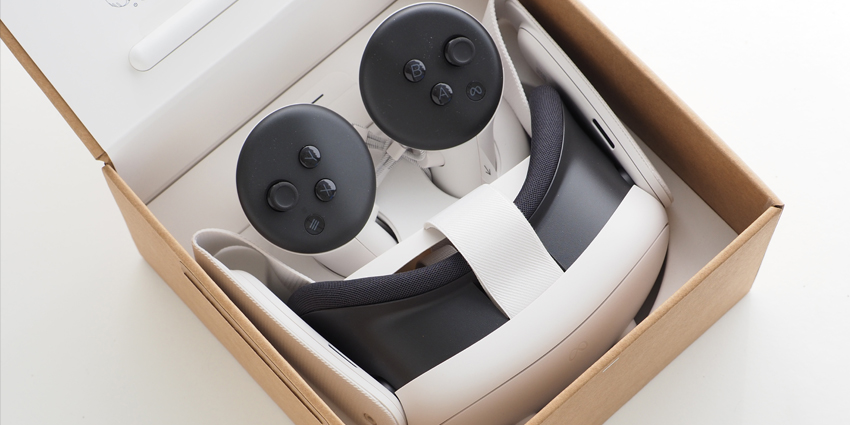Have you ever wondered, “How does virtual reality work?” How can the right combination of hardware and software instantly transport us into a new world? What components does a “virtual reality” experience need to be truly immersive?
In recent years, the “virtual reality” world has evolved drastically. Once, VR was a novel concept often alluded to in the science fiction landscape. Then, developers began to discover effective ways to produce unique VR experiences.
Gradually, VR headsets became more intuitive and sophisticated, and new technologies emerged to give us a unique experience of the digital landscape. Today, there are an estimated 171 million VR users worldwide, and headset shipments continue to grow.
So, how does virtual reality work, and why is it such a significant tech evolution?
How Does Virtual Reality Work? An Introduction
Virtual reality creates an end-to-end mechanism that replaces our natural “real-world” environment with an immersive simulation. Using a combination of hardware and software, VR solutions replace our real-world view with a computer-generated alternative.
To ensure the experience is immersive and realistic, virtual reality systems leverage a combination of infrared LEDs and motion sensors, cameras, and screens, which allow a headset to gather relevant information and present it to the human eye. Some solutions even use accessories to deepen the immersion, such as haptic feedback systems and spatial audio.
True virtual reality doesn’t simply fill your field of view with new information. It creates a simulated environment you can effectively interact with. Using AI, sensors, and algorithms, VR headsets orient the new “digital world” with the real world to deceive your brain into thinking you’re actually in a new environment.
So, why does virtual reality work? How is it so effective at influencing our perception?
Simply put, virtual reality operates on the basic principle that what we see, hear, and interact with shapes our understanding of the world. VR headsets are programmed to capture our responses to natural stimuli, and our responses are processed by AI-powered software.
This information is then used to create virtual objects in a spatially mapped environment to trick the human brain.
The Evolution of Virtual Reality
The answer to “How does virtual reality work?” may have been different a few years ago. Most people still see VR as an entirely new concept designed to power experiences linked to work, entertainment, and training. However, virtual reality has been around for decades. Some of the first headsets were initially produced in the mid-1990s.
Initially, these headsets offered a basic experience of “virtual reality,” which relied mainly on influencing what we saw when we wore a headset. Now, innovators have transformed virtual reality experiences with low-latency software and upgraded hardware.
Today’s virtual reality solutions don’t just include a headset, display, and motion controllers. They also feature real-time sensors that track a user’s movements, eyes, and gestures, creating a deeper connection between our actions and the AI-powered software behind the VR experience.
VR can now react rapidly to our behaviors, creating a new level of “spatial computing” experience where we can interact naturally with computer systems.
The Different Types of Virtual Reality
As the extended reality landscape has evolved, the development of various “VR experiences” has influenced the answer: “How does virtual reality work?”
On a broad level, all forms of virtual reality attempt to immerse users in an experience using a combination of sensors, artificial intelligence, and hardware (such as wearable headsets). However, there are various forms of virtual reality with their unique nuances.
How Does Virtual Reality Work for Non-Immersive VR?
When most people think of VR, they think of “fully immersive” experiences. However, there are various levels of immersion offered by virtual reality. The term “non-immersive VR” is a bit of a misnomer, as all forms of VR do offer some immersion.
However, with these types of VR, you only interact with the virtual environment on a fundamental level. There are no advanced “spatial computing” features like sensors or gesture controls. Instead, you use controllers to interact with a digital landscape.
Driving simulators are perhaps the best example of this. With a non-immersive VR driving simulator, you sit behind the wheel and interact with pedals like a real car. Some simulators even use haptic feedback to give you the feel of being in a vehicle. However, there’s usually no headset involved in this type of VR.
How Does Virtual Reality Work in Semi-Immersive VR?
Sometimes described as fundamental “mixed reality,” semi-immersive VR places digital components on top of real objects or environments. Usually, this form of VR is common in educational and entertainment environments.
For instance, aircraft crews and flight engineers can use semi-immersive heads-up displays (HUDs) to see digital content overlaid on windshields and other devices. This type of immersive reality is called semi-immersive because it doesn’t create the illusion of a different reality. Instead, you simply augment your natural environment, similar to augmented or mixed reality experiences.
How Does Virtual Reality Work with Fully Immersive VR?
Most people think of “fully immersive experiences” when they imagine VR. Tools like the Meta Quest 2 and Quest 3 are examples of fully immersive headsets. They provide a 360-degree simulated experience for users to step into.
With fully immersive VR, the world around you disappears, replaced by sounds, images, and even physical sensations that align with the image on a computer screen or display. These headsets use AI and sensor technology to respond to your actions and move you through a virtual world.
In some cases, fully immersive VR solutions can work alongside haptic accessories to convince your mind you’re touching and interacting with objects in a digital space.
How Does Virtual Reality Work? The Components of VR
Virtual reality experiences, in all of their forms, usually rely on a combination of various types of hardware and software. As mentioned above, these components have grown more advanced and sophisticated. They include:
VR headsets
VR headsets are one of the most significant components of many VR experiences. These are head-mounted wearable devices that wrap around a user’s eyes. They don’t just block you from seeing the outside world; they showcase specific information related to a VR simulation.
Essentially, they replace your natural field of view with a computer-generated alternative. VR headsets include screens, cameras, motion sensors, and infrared LEDs. They collect information from human senses and adapt to deliver an immersive experience.
Headsets also come in many forms, from wired devices that connect to your PC to standalone headsets like the Meta Quest.
Lenses and Screens
Within VR headsets, stereoscopic lenses are positioned between a screen (usually LED) and the eyes to distort the images and make them seem three-dimensional. The headset passes two images through the lenses (one for each eye).
Infrared cameras within the headset then adjust the light to the user’s needs, and trackers allow the device to shift the content on a screen as we move our heads to navigate. Some headsets can even track eye movement for foveated rendering.
Latency and Field of View
Latency and Field of View (FOV) are components within a VR headset that align virtual information with the real world. The average human sees the world around them in a 200 to 220-degree arc around the head. Our vision from our left and right eyes overlap at an angle, which allows us to see in three dimensions.
Generating a 3D environment that aligns with a user’s natural field of view is how VR headsets convince our minds we’re in a different world. How realistic the experience feels depends heavily on how our movements affect changes in what we see.
Minimal latency is necessary to ensure that what we see changes simultaneously when we move around, turn our heads, or look in a specific direction.
Frame Rate
Similar to latency and field of view, the frame rate of a VR device determines how immersive the experience is and how likely we are to encounter VR sickness. Though human eyes can see up to 1,000 frames per second, the brain only interprets frame rates up to 150 FPS.
Generally, the frame rate of a movie in a theater is only around 24 FPS, but these films aren’t intended to simulate reality. VR developers find anything less than a rate of 60 FPS causes nausea and headaches.
Spatial Audio
Spatial audio has become increasingly important in any VR experience in recent years. Sound and where it comes from influence our perception of a three-dimensional space. Today’s cutting-edge VR technology uses intelligent technologies to position sound around our heads.
This means if we’re walking through a meeting room in virtual reality and someone calls our name from “behind us” in the setting, we hear that sound coming from behind us.
Many audio innovators have used this type of “3D” audio for several years, including YouTube, Spotify, and even Google’s VR audio system.
Head, Movement, and Position Tracking
Convincing, real-to-life visuals and sound are essential to creating an immersive experience. But the real magic of VR comes from the fact that we can move around and interact with a space that adapts to our position and actions.
Head and position-tracking technologies use a combination of sensors, gyroscopes, and AI to influence what we see as we move around. Basic headsets initially used three degrees of freedom (3DoF) systems, which only allowed us to look left, right, and up and down.
Today’s most advanced headsets, like the Varjo XR-4, use six degrees of freedom to ensure we can look around in a 360-degree format, just like we would in real life.
Virtual Reality Controllers
Although some VR innovators are experimenting with spatial computing technologies like sensors and trackers to minimize the need for controllers, many headsets still feature connected controllers.
These are basically hardware components that allow users to take action and do things in a virtual environment. Think of the controllers you use with the Meta Quest 2 or 3, for instance. Controllers allow us to submit information about what we want to do to VR software directly.
However, as companies continue to develop more advanced body and movement tracking capabilities, the answer to “How does virtual reality work?” might change. We may not need controllers to navigate the VR landscapes of tomorrow.
Virtual Reality Software
Virtual reality software is essentially the component of a VR solution that combines things like latency, position tracking, frame rate, and position tracking with 3D environments. Like most software, VR software is incredibly versatile and can be adapted to suit various needs.
Some developers even offer access to “virtual reality as a service” solutions, allowing companies to create industry-specific user experiences. These technologies can create collaborative environments, like Microsoft Teams’ Immersive spaces, training simulations, and more.
Most VR software will include all the data and code required to produce a 3D virtual world and avatars. They also ensure information can be streamed effectively through a headset. Some of the latest VR software on the market can also integrate with existing tools, like collaboration platforms, communication systems, and content management systems.
How Does Virtual Reality Work? The Use Cases
If you’re wondering how virtual reality works, you may also wonder what it’s used for. In the past, VR headsets and experiences were usually seen as tools for the entertainment industry. While VR is still common in gaming and other entertainment landscapes, the use cases are evolving.
For instance, VR in recruitment allows employers to find unique ways of interacting with and onboarding new team members. In construction and development, VR environments can help teams work together on developing three-dimensional blueprints or experiment with designs using digital twins. VR can help teams to collaborate in immersive environments that replicate the sensations of face-to-face interactions.
Plus, VR even has applications in the customer service landscape, helping companies to show products to customers, create immersive demos, and even troubleshoot issues. Other use cases include:
- Immersive training and educational experiences
- Product design and development
- Tourism and travel
- Healthcare and telehealth
Virtual reality is also one of the primary technologies helping to drive the creation of “metaverse” experiences in their many forms. Used correctly, VR can deliver many benefits to users, from enhancing collaboration to improving human connections.
The Challenges Facing Virtual Reality
The answer to “How does virtual reality work?” has changed somewhat over the years, as developers and innovators have encountered various challenges with creating immersive experiences. These challenges are still driving transformation in the VR space today.
For instance, leaders like Varjo, HTC VIVE, and Microsoft are still working to address the “VR sickness” issue and the discomfort we feel when we’re exposed to VR for long periods. At the same time, the introduction of “metaverse” environments and the growing adoption of VR unveils potential issues with everything from ethics to cyber security.
Moreover, while headsets are becoming more affordable, creating VR tools and software is still expensive and time-consuming. Creating intuitive VR environments requires significant investment and may impact the environment due to high-level computing requirements. All these issues need to be addressed to create a world where everyone can discover the benefits of virtual reality.
The Future of Virtual Reality
The good news for those interested in the potential of virtual reality and how it works to transform our world is that VR solutions are constantly evolving. By 2030, experts predict the VR market will grow at a CAGR of 27.5% as innovators explore new opportunities.
In the years ahead, the answer to “How does virtual reality work?” will continue to evolve as we discover new ways to make hardware, new opportunities in spatial computing, and even more advanced artificial intelligence algorithms.
Going forward, we’ll continue to discover better ways of addressing the challenges VR experiences pose and create more immersive experiences for every user.









